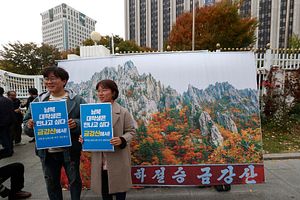On October 25, North Korean leader Kim Jong Un ordered that the “unpleasant-looking facilities” in the Mount Kumgang tourist district, set up by South Korean companies, be demolished in cooperation with South Korean authorities. The message, signed off by the new North Korean Mt. Kumgang International Tourism Bureau, poses a predicament for the South Korean government regarding the appropriate response and way forward.
The flagship tourist resort, located on the eastern coast of the Korean Peninsula, was set up in 1998 and acquired symbolic importance representing inter-Korean cooperation and exchange. Even though inter-Korean tourism halted in 2008, the venue has been used to host reunions for separated families.
South Korea Unification Minister Kim Yeon-chul stated that North Korea’s demolition orders are aimed at coercing Seoul to restart the inter-Korean project. The Ministry of Unification announced that “creative solutions” would be sought in order to resolve this issue. At a think tank conference in Seoul, experts noted that individual tourism is not prohibited by international sanctions and South Korea could implement policies that would facilitate up to 17 million tourists visiting South Korea to also visit Mt. Kumgang.
Domestic pressure is mounting on the Moon administration as civil groups are pushing for the resumption of Mt. Kumgang tourism. Last October, a pan-national organization made up of over 100 civil groups was set up to promote the resumption of the Kaesong Industrial Complex and Mt. Kumgang tourism. In addition, last week, Governor Choi Moon-soon of Gangwon Province, a region close to Mt. Kumgang that has suffered economic losses due to the suspension of the tours, visited the United States to request U.S. cooperation in resuming that tourism.
However, resuming Mt. Kumgang tourism would not be prudent at this time for three reasons.
First, it must be remembered why Mt. Kumgang tourism was suspended. In July 2008, a South Korean tourist was fatally shot by a North Korean soldier after straying into an unauthorized area. After 11 years, it was only in early 2019 that the leaders of South and North Korea agreed to discuss resuming joint Korean projects under the right conditions. While it is arguable what those right conditions might have been, it would be politically inappropriate to consider resuming tourism when North Korea has yet to apologize for the 2008 incident and South Korea cannot guarantee the safety of Korean investors, businesses, and tourists.
Second, it is unclear how individual tourism would be carried out. In the beginning, Hyundai Asan invested 226.8 billion won in facilities and $486.69 million to purchase land and operational rights from North Korea. The company organized group tourism and payment was set up so that fees were given directly to North Korean authorities. At present, direct payment from Hyundai Asan to North Korean authorities would violate Article 11 of the UNSC Resolution 2094 which prevents bulk cash from entering North Korea.
If individual tourism is allowed, each visitor would personally pay for their own expenditure, which technically does not violate the terms of the resolution. But in whatever form individual tourism is carried out, it still violates the spirit of the international sanctions regime. It is impossible to guarantee that payments in or to North Korea are not channelled to organizations that are sanctioned by the UNSC. The UN resolution also does not set a lower limit as to what amounts to bulk cash. The cumulative sum of money entering North Korea may amount to bulk cash, just in smaller units.
Third, there is also the tricky issue of ROK-U.S. relations. On November 17, Unification Minister Kim left for the United States on a seven-day trip to discuss the situation on the Korean Peninsula. The visit came in the context of a growing unease in ROK-U.S. relations. Specifically, the United States has pressured South Korea to resume the General Security of Military Information Agreement (GSOMIA) with Japan while also requesting that Seoul increase its share of defense costs. Unsurprisingly, South Korean public perception has been negative, believing that the U.S. has sided with Japan over GSOMIA and undermined the ROK-U.S. alliance through requesting excessive cost sharing.
How the Mt. Kumgang tourism issue progresses will also affect ROK-U.S. relations in the short term. Seoul’s experimentation with individual tourism as an opportunity to encourage or mediate U.S.-North Korea talks will backfire if Pyongyang does not take steps to denuclearize. On the other hand, if Minister Kim’s visit merely confirms the diverging positions held by Seoul and Washington, it may lead to popular resentment toward the United States fuelled by those in South Korea who see ROK-U.S. relations as inhibiting inter-Korean relations.
At present, a more desirable path for South Korea would be to communicate to North Korea that inter-Korean projects are likely to make progress when North Korea shows commitment to denuclearization. While the suspension of Mt. Kumgang tourism was due to an inter-Korean incident, North Korea’s nuclear weapons development and testing are what led to international sanctions blocking inter-Korean projects. In the current circumstances, resumption of Mt. Kumgang tourism has become unavoidably linked to North Korea’s denuclearization.
Ultimately, a more circumspect response would benefit South Korea. If North Korea unilaterally demolishes South Korean-built facilities and assets, it would severely damage inter-Korean relations and make it difficult for Korean companies to invest in future projects. North Korea is likely aware of this, as well as the fact that without South Korean support, it is questionable how sustainable the Kumgang tourist district will be. Absent North Korea’s apology for the 2008 incident, guarantee of tourist safety, and suspension of nuclear or missile threats, South Korea should not be in a hurry to seek a “creative solution.”
Saeme Kim is a Ph.D. candidate at King’s College London. Her research interests include Asian regionalism, security in Northeast Asia, and middle power diplomacy.

































